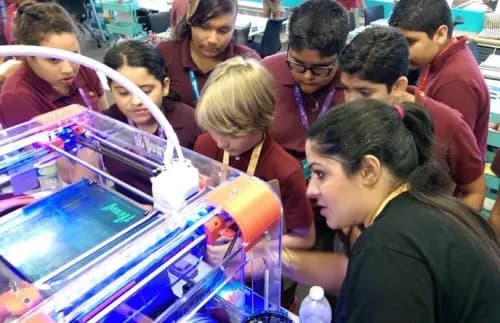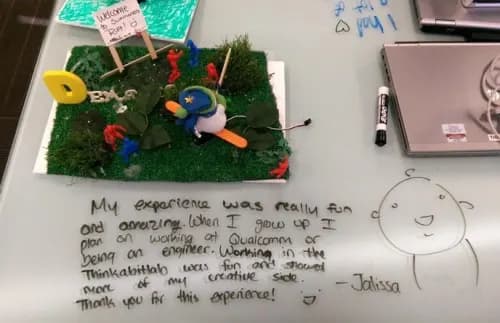How This Company’s Woman-Led Thinkabit Lab is Inspiring the Next Generation of STEM Leaders
Since it began, Qualcomm Thinkabit Lab has exposed more than 12,000 students, teachers and parents to hands-on STEM (Science, Technology, Engineering and Math) activities and career exploration discussions that will prepare them for 21st-century jobs. The lab moved beyond its San Diego roots (the first Thinkabit Lab debuted at Qualcomm headquarters in 2014) last year, with the opening of a lab at Virginia Tech University. Now, the program takes another step toward its goal: to create more labs in schools locally, nationally and even globally. Today marks the launch of the Qualcomm Thinkabit Lab Toolkit, a set of resources that school districts, libraries, universities, and businesses can use to create their own Thinkabit Lab-inspired sites, wherever they are.
The Thinkabit Lab Toolkit, which is free, is based on the “signature activities” offered at the Thinkabit Lab headquarters in San Diego. These activities include Thinkabit Lab’s original robo-crafting projects, Qualcomm World of Work career exploration activities and projects that focus on the Internet of Things and 5G. And the relationship doesn’t end there — Qualcomm will continue to collaborate with participants, providing guidance and sharing best practices as they create their makerspaces where students can invent, design and build.
Qualcomm is Hiring! Browse Opportunities.
To understand more about Thinkabit Lab’s “next step,” we spoke with engineer extraordinaire and fierce STEM advocate Susie Armstrong, who serves as the senior vice president of engineering at Qualcomm Inc. and lead of the Thinkabit Lab:
You’ve been involved with Thinkabit Lab for almost two years. What’s a favorite moment of yours?
You can’t make me pick a favorite moment! Certainly one of them is watching the kids present their projects. They create these inventions and most of them work, but sometimes there are technical difficulties. Watching them present their inventions is always really powerful.
Another favorite moment is seeing the impact on the teachers, administrators, and parents when they watch the kids participate in the program. Their eyes light up because they know that there’s a tangible, hands-on and creative place kids can go.
I have seen that. And I’ve heard parents whose kids have participated in the Thinkabit Lab program here say, “Wow, what did you do to my kid?” or “What did you do to the kid that I knew?”
Yes, exactly. And a lot of these students will take the career cards they picked out in the Qualcomm World of Work and attach them to their school badges and bed posts. It gives them a goal to aspire to.
There’s STEM aspects in every career, such as critical thinking and problem solving. We don’t expect that every one of our students is going to become a chip designer, doctor or computer scientist, but they’ll know that they have that option. They can invent things and produce things, rather than only consume them.

What are you most excited to see with regard to the expansion of Thinkabit Labs?
We’re planning on expanding Thinkabit Lab to more universities and their makerspaces. We love these university partnerships — the universities are excited about having their own students teach younger students in spaces inspired by the Thinkabit Lab.
We’ve also had a strong reaction from teachers who say: “Oh, geez. I not only want to do this in my lab, but how do I, as a teacher, actually learn these kinds of concepts and teach these things?” One of our Thinkabit Lab teachers is working on a program where we put together specific teacher training. We want to give them the support they need, and want to make sure that these teachers provide feedback, so we can make these programs even more impactful for them.
Have you seen the “signature activities” evolve over the years?
I visited the Thinkabit Lab program in Virginia Tech with 40 high school art teachers. We had so much fun during the creative process that Dr. Jim Egenrieder, the director of the Thinkabit Lab in Virginia Tech, said: “I have never seen a class use so many materials or make such a mess!”
It was really interesting to experience it with adults and art teachers — they brought so much creativity to it. It was fascinating and it was my favorite activity.
Some of the new activities that the team’s working on are beyond robo-crafts. They’re taking robo-crafts and relating them to the Internet of Things. My current favorite project is a clothes-finding device. A sixth-grader came up with the idea of attaching sensors to his clothes because his clothes were always in a pile and he couldn’t figure out which clothes to wear. In his invention, there’s a little arrow on the dresser that senses the clothes and swings over to whichever shirt is at the top of the pile. I saw it and thought, “I need that for my reading glasses!”
That’s cool! Tell me more about the “signature activities” for the Toolkit.
Four or five activities make up the engineering portion of the Thinkabit Lab in a one-day experience. In the Toolkit, the resources are for the teacher. First, we teach how to wire up a breadboard, with a little Arduino board, and make an LED light flash. Then, we show how to wire it up and program it to make a servo move. Now that they know how to make a servo move, the teachers and students can control movement and mechanics, and can create their own robot crafts. The last activity would be the students’ presentations.
What makes Thinkabit Lab so unique? What sets it apart from similar tech programs?
First and foremost, it’s tangible and hands-on. It’s taught live through teachers. Second, it’s done in the framework of careers. And third, it’s creative and clever, and it’s not a prescribed outcome. You’re making your own inventions. And it’s powerful to have somebody actually interacting with students in-person.

What would you want parents to come away thinking about Thinkabit Lab and Qualcomm?
I would want them to come away with the same thoughts as their children — that STEM careers, or any good career, might be a path for the student or for themselves. Kids need their parents’ support and direction. We’ve actually had a lot of students go through World of Work and say, “My parents never asked me that.” Or parents will say, “You know what? I never really asked my kid what they were interested in.”
We’re trying to inspire kids to pursue these careers if they love invention. The philosophy that guides us is: How do we continue to inspire the next generation of STEM inventors, innovators, and engineers?
To learn more, visit the Qualcomm Thinkabit Lab website.
--
A version of this article originally appeared on the OnQ Blog. Fairygodboss is proud to partner with Qualcomm. Find a job there today!
Why women love us:
- Daily articles on career topics
- Jobs at companies dedicated to hiring more women
- Advice and support from an authentic community
- Events that help you level up in your career
- Free membership, always
